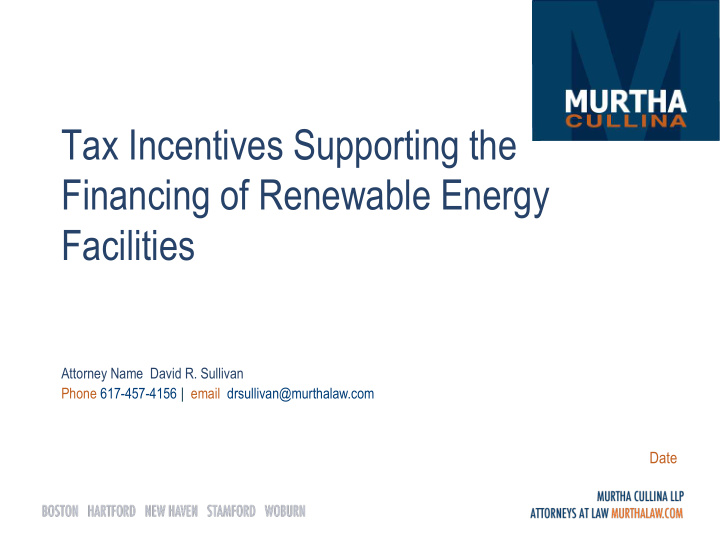



Tax Incentives Supporting the Financing of Renewable Energy Facilities Attorney Name David R. Sullivan Phone 617-457-4156 | email drsullivan@murthalaw.com Date
• Broad Public Support • Currently nearly all States have adopted some form of Renewable Energy Portfolio (“RPS”) standards • While Wind and Solar are most often in the new Incentives Apply to other Renewable Technologies
• Federal Credits Still Available Production Tax Credit (IRC Section 45) • Investment Tax Credit (IRC Section 48) •
• Production Tax Credit Subsidizes Production by providing a tax credit based on the number of Kilowatt Hours produced. In BioMass space, there is a distinction between Closed Loop and Open Loop BioMass facilities
• Closed Loop Biomass facilities are fueled with plant matter grown for that purpose • Open Loop facilities are fuelled with Livestock Waste and other solid cellulosic and lignin material • A Biomass facility does not include any facility which cofires with fossil fuel
• Production Tax Credits are generally available for ten years after the facility is placed in service. • Rates for Closed Loop credit id 50% of the rate for Open Loop credits • Other financing enhancement (such as exempt bonds or grants) can reduce the PTC by up to 50%
• Investment Tax Credits: Based on the eligible cost of the facility (30%) • Taxpayer must elect to take this in lieu of PTC • Reduction in Depreciable Basis of 50% of Credit • Taken in the year the Project is placed in Service • • Subject to recapture for five years
• Eligible Costs Generally the cost of depreciable personal property or other depreciable property other than a building or its structural components. Can include roadways and support facilities located on site which are an integral part of the facility.
• Election to Use ITC • Taxpayer must make an affirmative election to use ITC in lieu of PTC • Critical factor is the ratio of cost to anticipated production • Additionally in the case of Open Loop facilities of facilities funded with exempt bonds, the lower PTC rates will apply.
• Tax Incentives and Limitations: The use of tax incentives is limited by the • Developers ability to utilize credits. Limitations may be based on the other tax liability • of the Developer which can be offset.
• Monetizing Tax Incentives: Tax incentives are most often “sold” to a credit • investor Provides low cost investment funding since the tax • benefits greatly increase the rate of return • Typical structures include a Partnership structure or a lease structure
• Combining with other incentive Depending on the state, there may be important incentives that • pertain, such as REC’s, grants or direct financial support . Exempt Bond Financing may be available. • New Market Tax Credit if the project is located in development • district. Even historic tax credits could be available if a suitable site could be • found
• Life of tax incentives: Federally, incentives have continued solely through • the device of “extenders” Currently most renewable credits would not be • available after 2016. • American Energy Innovation Act (September 2015) would provide long term extension of credits. •
• On the other hand, Sen. Lankford introduced legislation in October that would end all energy subsidies. Likely result will be a trade off of extended credit for • lifting oil export limits.
Recommend
More recommend